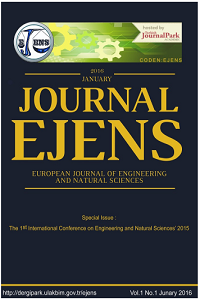Development of Ecological Biodesign Products by Bacterial Biocalcification
Development of Ecological Biodesign Products by Bacterial Biocalcification
Biocalcification, Biodesign, Urban Living Elements,
___
- [1] L. S. Wong, “Microbial cementation of ureolytic bacteria from the genus Bacillus: a review of the bacterial application on cement-based materials for cleaner production,” J. Clean. Prod., vol. 93, pp. 5–17, 2015.[2] I. Fjørtoft and J. Sageie, “The natural environment as a playground for children,” Landsc. Urban Plan., vol. 48, pp. 83–97, 2000.[3] I. Fjørtoft and J. Sageie, “The natural environment as a playground for children. Landscape description and analyses of a natural playscape,” Landsc. Urban Plan., vol. 48, no. 1–2, pp. 83–97, 2000.[4] E. M. Campa, “Pensamientos compartidos. Aldo van eyck, el grupo cobra y el arte,” Rev. Proy. Progreso, Arquit., no. 11, pp. 64–75, 2014.[5] M. Taya, “Bio-inspired design of intelligent materials,” Smart Struct. Mater., vol. 5051, pp. 54–65, 2003.[6] D. Olivera-Severo, G. E. Wassermann, and C. R. Carlini, “Bacillus pasteurii urease shares with plant ureases the ability to induce aggregation of blood platelets,” Arch. Biochem. Biophys., vol. 452, no. 2, pp. 149–155, 2006.[7] S. Stocks-Fischer, J. K. Galinat, and S. S. Bang, “Microbiological precipitation of CaCO3,” Soil Biol. Biochem., vol. 31, no. 11, pp. 1563–1571, 1999.[8] J. H. Yoon, K. C. Lee, N. Weiss, Y. H. Kho, K. H. Kang, and Y. H. Park, “Sporosarcina aquimarina sp. nov., a bacterium isolated from seawater in Korea, and transfer of Bacillus globisporus (larkin and stokes 1967), Bacillus psychrophilus (Nakamura 1984) and Bacillus pasteurii (Chester 1898) to the genus Sporosarcina as Sporosa,” Int. J. Syst. Evol. Microbiol., vol. 51, no. 3, pp. 1079–1086, 2001.[9] W. R. Wıley and J. L. Stokes, “Requirement of an alkaline pH and ammonia for substrate oxidation by Bacillus pasteurii.,” J. Bacteriol., vol. 84, pp. 730–734, 1962.[10] R. Siddique and N. K. Chahal, “Effect of ureolytic bacteria on concrete properties,” Construction and Building Materials, vol. 25, no. 10. pp. 3791–3801, 2011.[11] S. J. Park, Y. M. Park, W. Y. Chun, W. J. Kim, and S. Y. Ghim, “Calcite-forming bacteria for compressive strength improvement in mortar,” J. Microbiol. Biotechnol., vol. 20, no. 4, pp. 782–788, 2010.[12] Q. Chunxiang, W. Jianyun, W. Ruixing, and C. Liang, “Corrosion protection of cement-based building materials by surface deposition of CaCO3 by Bacillus pasteurii,” Mater. Sci. Eng. C, vol. 29, no. 4, pp. 1273–1280, 2009.[13] J. Wang, K. Van Tittelboom, N. De Belie, and W. Verstraete, “Use of silica gel or polyurethane immobilized bacteria for self-healing concrete,” Constr. Build. Mater., vol. 26, no. 1, pp. 532–540, 2012.[14] H. M. Jonkers and E. Schlangen, “Crack Repair By Concrete-Immobilized Bacteria,” Civ. Eng., no. April, pp. 1–7, 2007.[15] B. Mahanty, S. Kim, and C. G. Kim, “Biokinetic modeling of ureolysis in Sporosarcina pasteurii and its integration into a numerical chemodynamic biocalcification model,” Chem. Geol., vol. 383, pp. 13–25, 2014.[16] H. M. Jonkers and M. C. M. van Loosdrecht, “BioGeoCivil Engineering,” Ecological Engineering, vol. 36, no. 2, pp. 97–98, 2010.[17] N. K. Dhami, M. S. Reddy, and A. Mukherjee, “Bacillus megaterium mediated mineralization of calcium carbonate as biogenic surface treatment of green building materials,” World J. Microbiol. Biotechnol., vol. 29, no. 12, pp. 2397–2406, 2013.[18] S. S. Bang, J. K. Galinat, and V. Ramakrishnan, “Calcite precipitation induced by polyurethane-immobilized Bacillus pasteurii,” Enzyme Microb. Technol., vol. 28, no. 4–5, pp. 404–409, 2001.[19] G. D. O. Okwadha and J. Li, “Optimum conditions for microbial carbonate precipitation,” Chemosphere, vol. 81, no. 9, pp. 1143–1148, 2010.[20] V. Achal, A. Mukherjee, and M. S. Reddy, “Microbial concrete: Way to enhance the durability of building structures,” J. Mater. Civ. Eng., vol. 23, no. 6, pp. 730–734, 2011.[21] M. Sarmast, M. H. Farpoor, M. Sarcheshmehpoor, and M. K. Eghbal, “Micromorphological and biocalcification effects of Sporosarcina pasteurii and Sporosarcina ureae in sandy soil columns,” J. Agric. Sci. Technol., vol. 16, no. 3, pp. 681–693, 2014.
- Başlangıç: 2015
- Yayıncı: CNR Çevre
Wastewater Treatment by Floating Macrophytes (Salvinia Natans) Under Algerian Semi-Arid Climate
Laabassi AYACHE, Boudehane ASMA
An Image-based Recommender System Based on Image Annotation
Kemal ÖZKAN, Zühal KURT, Erol SEKE
Investigation of Notch Root Strain Behaviors Under Combined Loadings
Toros Arda AKSEN, Emre ESENER, Mehmet FIRAT
Development of Ecological Biodesign Products by Bacterial Biocalcification
Tuğba Keskin Gündoğdu, İrem DENİZ, Alpcan ARİC, Burak Talha YILMAZSOY, Ozge ANDİC CAKİR, Aysegul ERDOGAN, Didem ALTUN, Ayca TOKUC, Burcu Filiz DEMİRCİ, Aylin SENDEMİR, Gulden KOKTURK, Feyzal Ozkaban
Kinetics of Granulated Waste Tyre Pyrolysis via Thermogravimetry and Model-Free Methods
Peter T. CHEROP, Sammy L. KİAMBİ, Paul MUSONGE
Determination of Turbidity in Filyos Stream Water by Artificial Neural Network
Berna AKSOY, İsmail Hakkı ÖZÖLÇER, Emrah DOĞAN, Onur DÜNDAR
The Usage of Modified Chitosan for the Removal of Hexavalent Chromium from Waste Water
Developments and Applications in Enzyme Activated Membrane Reactors
Nadir DİZGE, Ruken Esra DEMİRDOGEN, Kasım OCAKOGLU
Determination of The Hip Stem Loosening Using Vibration Method
An Alternative Method for Long-Term Land Cover Change Detection: A Case Study of Hasanlar Dam
